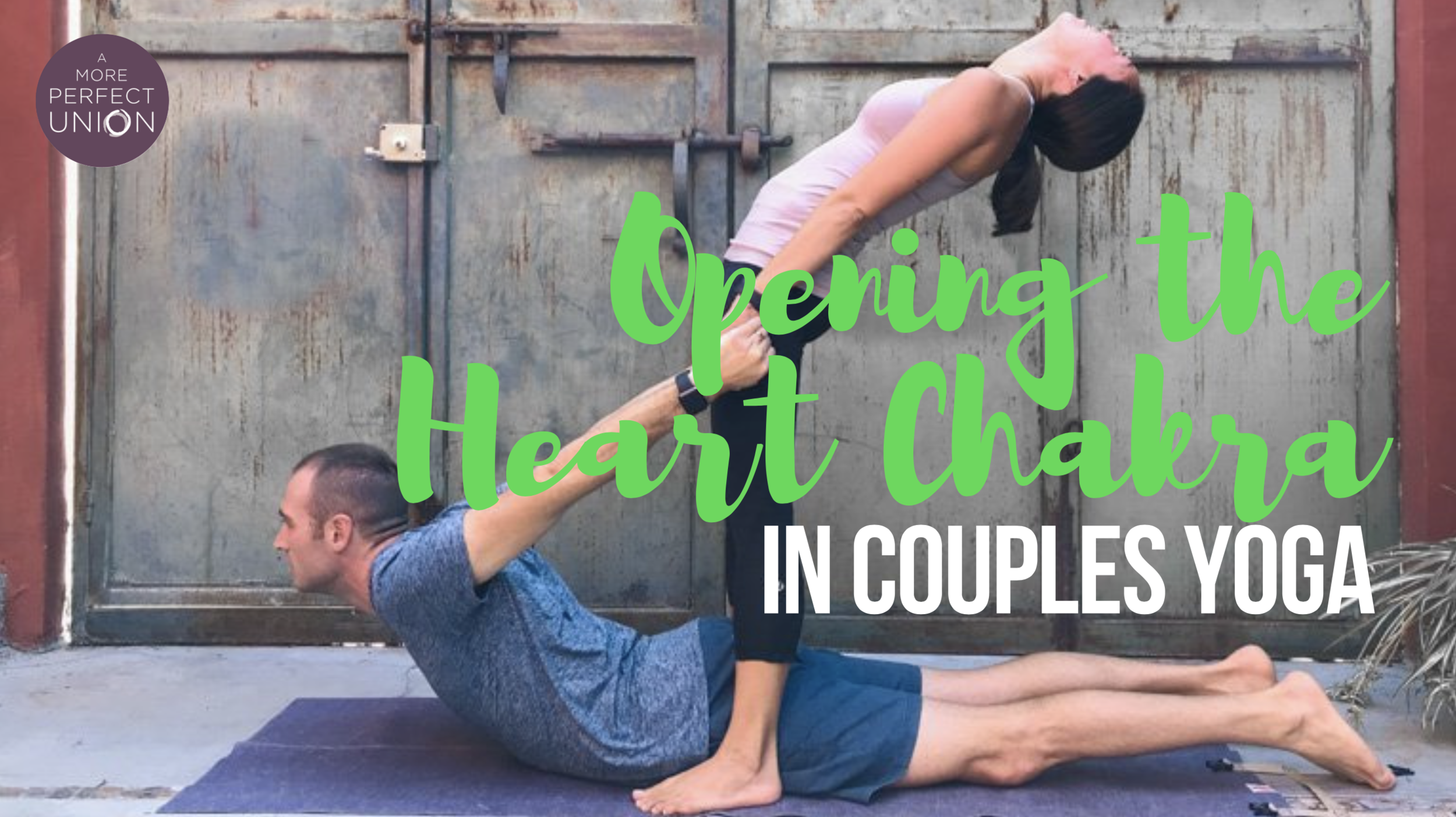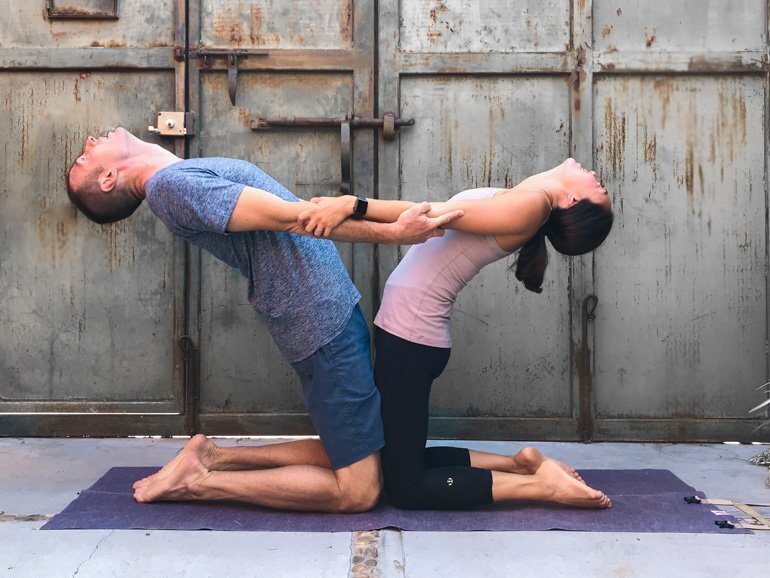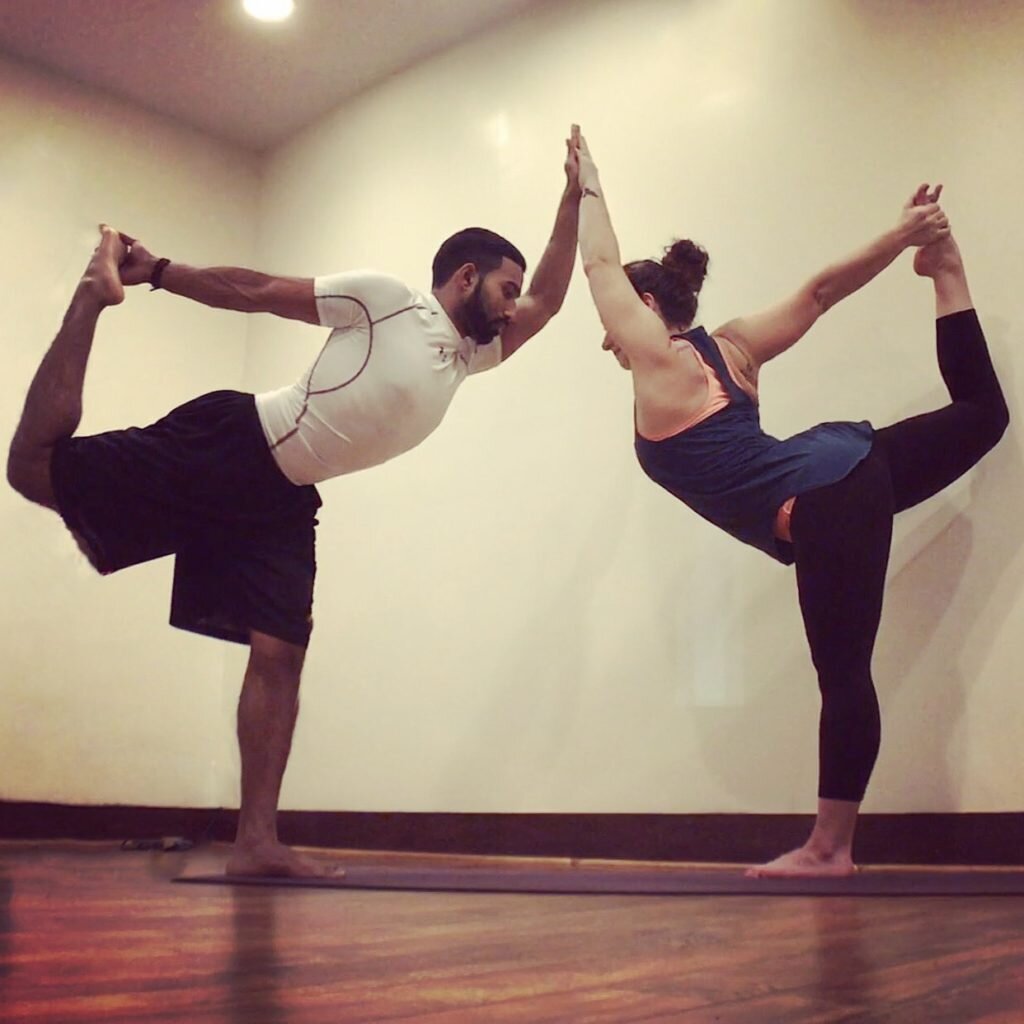Opening the Heart Chakra in Couples Yoga
The heart chakra, or anahata chakra, is one of the 7 chakras or energy centers that run up the central axis of the body. Its location is said to correspond to the chest cavity where the heart itself resides. Associated with the color green, the heart chakra is fourth from the base of the spine, as well as fourth from the crown of the head. As the center point of the seven chakras, this energy center is said to be where the physical and spiritual meet. In Sanskrit, the word anahata means “unstruck,” and when this chakra is properly aligned, past hurts are said to no longer harm us. When balanced, we are filled with love, compassion, and self-acceptance. When imbalanced, we can be angry, jealous, sad, and untrusting.
The heart chakra plays such an important role in maintaining balance, cultivating compassion, and projecting positivity. Therefore, it helps to know how to open it up to ensure it’s flowing to the best of its abilities. This is often the most popular chakra to work with because of its association with love. But don’t forget that every chakra has equal value and one chakra cannot operate optimally without the others in equal good balance. It is an integrated system.
In heart opening yoga poses, we are exposed. We practice heart openers as a gateway to our vulnerabilities. Nothing stands between our hearts and the rest of the world—not our crossed arms, not our books or devices. It is an arms-wide-open stance, allowing our beating hearts to BE - for a blissful moment - unguarded. So grab a friend, your partner or your spouse and let’s get vulnerable together!
4 Yoga Poses to Open Your Heart and Activate the Heart Chakra:
As you prepare to practice these heart opening poses, let your mantra be “I live with an open heart.” Breathe it in and breathe it out. Together.
Ustrasana (Camel pose)
CAMEL POSE — Ustrasana (ooh-STRAHS-uh-nuh) — is a backbend that stretches the whole front of the body. It is performed on the knees and is often used as preparation for deeper backbends.
Begin by kneeling upright with your knees hip-distance apart, facing your partner. Rotate your thighs inward and press your shins and the tops of your feet into the floor. If the pose is too intense with the tops of the feet down, you can always curl the toes underneath. Do not squeeze your buttocks.
Rest your hands on the back of your pelvis, with your fingers pointing to the floor. Lengthen your tailbone down toward the floor and widen the back of your pelvis.
Lean back away from your partner, with your chin slightly tucked toward your chest. Beginners can stay here, keeping their hands on their back pelvis.
If you want to take it further, reach for your partner’s forearm or upper arm, inhale to engage your lower belly and reach your tailbone toward your knees, creating space between your lower vertebrae.
On another inhalation, lift your sternum and draw your elbows toward each other, allowing your rib cage to expand. Extend your arms long, moving away from your partner. Bring the gaze up overhead or slightly behind you. Hold for 30-60 seconds.
To release, bend your elbows and pull your partner up (and in essence they will bring you up). Inhale, lead with your heart, and lift your torso by pushing your hips down toward the floor. Your head should come up last. Rest in Child’s Pose (Balasana) or Corpse Pose (Savasana).
Bhujangasana (Cobra pose)
COBRA POSE — Bhujangasana (booj-ahn-GAH-sah-nuh) — is a basic Hatha yoga and as such, is very often practiced either on its own, or as part of the Sun Salutations.
Bhujanga means snake in Sanskrit, and in this pose we imitate a snake lifting its head while working the shoulders, upper back and spine. The Bhujangasana is also believed to be a great aid for the digestive fire, helping to purify the body.
Lie on your belly. Place your palms flat on the ground directly under your shoulders. Bend your elbows straight back and hug them into your sides.
Pause for a moment looking straight down at your mat with your neck in a neutral position. Anchor your pubic bone to the floor. Spread your toes wide and press the tops of your feet into your mat.
Inhale to lift your chest off the floor. Roll your shoulders back and keep your low ribs on the floor. Make sure your elbows continue hugging your sides. Don't let them wing out to either side.
Your partner squats at your feet, reaching their arms out to catch your forearms.
Release your hands from the floor engaging the muscles of the back. Reach back behind you to catch your partners forearms. There are 2 possible arm rotations, hands facing in or out. However, your elbows should always face in.
Exhale to release back to the floor and release your cheek to the mat or push back to Downward Facing Dog (Adho Mukha Svanasana)
Urdhva Dhanurasana (Full Wheel)
FULL WHEEL POSE — Urdhva Dhanurasana (OORD-vah don-your-AHS-anna) — is a backbend that requires building up strength and flexibility to achieve it. It opens the chest, shoulders, and hips in a way that counteracts the typical modern-day sitting posture. This partner pose is a little more complicated, so I’m going to break it down using Partner A for the BASE, and Partner B for the one going into Urdva Dhanurasana.
Partner A moves into a tabletop position/hands and knees, and then brings their forearms to the floor.
Partner B faces the same direction as Partner A and sits on their sacrum.
Partner B slowly lowers back and down, holding onto Partner A’s hips for support.
Once in the full backbend, Partner B can release their hands to reach for the tops of their feet.
To come out, Partner A curls their toes under and slightly lifts their hips up, to make it easier for Partner B to slowly lift upright to a sitting position.
You may be saying, um, that’s not what’s in the photo. And yes, you’re right. If the above is comfortable for both of you, let’s move on. After #4:
Partner A moves their hands up overhead, extending their arms long. They are now in Puppy Pose - Uttana Shishosana.
Partner A curls their toes underneath, and presses into the hands. Lastly, they bring their tailbone up and back, moving into Downward Facing Dog.
To release, Partner A brings their knees back down to the mat, and their forearms. And then just like above, Partner A curls their toes under and slightly lifts their hips up, to make it easier for Partner B to slowly lift upright to a sitting position.
Both Partners should then take a few breaths in Child’s Pose (Balasana)
Natarajasana (King Dancer pose)
KING DANCER POSE — Natarajasana (not-ah-raj-AHS-anna) — will require balance for both partners. King Dancer (or Lord of the Dance pose, as it’s also referred) is an intermediate, standing yoga pose that combines the challenging aspects of balancing with a backbend. It can help boost balance, stretch the legs and the back, and increase trust in your partner.
Begin in Mountain Pose (Tadasana), standing approximately four or five feet from your partner facing one another.
Shift your weight onto your left foot.
Grab your partner’s left hand with your left hand.
Each of you, bend your right knee and bring your right heel toward your right buttock. Reach your right hand down and clasp your right foot’s inner ankle. You can also loop a strap around the top of your right foot, and then hold onto the strap with your right hand. Draw your knees together.
Fix your gaze softly at an unmoving spot in front of you. Make sure your left kneecap and toes continue to point directly forward. Together, raise your left arms up to the sky.
When you feel steady and comfortable, begin to press your right foot away from your body as you simultaneously lean your torso slightly forward. Keep your chest lifting and continue reaching your left hand’s fingertips up toward the ceiling.
Raise your right foot as high as you can. Bring your right thigh parallel to the floor, or higher if possible. At the same time, press your tailbone toward the floor to avoid compressing your lower back. Do not let your right knee splay open to the side.
Root down through the big toe mounds while lifting the inner arches
Counter the backbends with Standing Forward Fold (Uttanasana).
If you need more guidance, or would like more information about a couple’s yoga or Wedding Yoga practice, please reach out and let me know!





